In the digital-first economy, web accessibility has emerged as both a moral obligation and a business-critical requirement. With growing legal mandates, rising consumer expectations, and expanding digital touchpoints, ensuring that websites and platforms are accessible to all users—including those with disabilities—is no longer optional. It is foundational to inclusive growth, regulatory compliance, and brand trust.
Defining Web Accessibility
Web accessibility refers to the design and development of digital experiences—websites, tools, and technologies—that enable people with disabilities to perceive, navigate, understand, and contribute to the digital ecosystem. As outlined by the World Wide Web Consortium (W3C), accessibility must encompass the full spectrum of impairments, including:
- Visual (blindness, low vision, color blindness)
- Auditory (hearing loss or deafness)
- Motor/Physical (limited fine motor control, paralysis)
- Cognitive and Neurological (dyslexia, autism, memory impairments)
- Speech (inability to speak or voice limitations)
True accessibility requires removing digital barriers, enabling all users—regardless of ability—to participate fully in the online experience.
Why Accessibility Matters: Strategic and Societal Value
1. Regulatory Compliance
Non-compliance with accessibility standards such as WCAG (Web Content Accessibility Guidelines) and laws like the Americans with Disabilities Act (ADA) can result in litigation, fines, and reputational damage. Accessibility compliance is no longer an option—it’s enforceable.
2. Expanded Market Reach
Over 1 billion people globally live with some form of disability. Inclusive design allows organizations to tap into this underserved segment and foster greater brand loyalty.
3. Enhanced User Experience
Accessible design improves usability for all users—think of closed captions benefiting non-native speakers or voice navigation helping users in hands-free environments.
4. Positive Brand Differentiation
A commitment to accessibility reflects corporate social responsibility and positions brands as ethical and user-centric.
Introducing UserWay: A Scalable Solution for Digital Accessibility
UserWay is a leading innovator in AI-powered accessibility solutions. Its suite of tools helps businesses of all sizes enhance compliance, improve inclusivity, and streamline their path to accessibility excellence.
Key Capabilities:
- Accessibility Widget
A customizable interface enhancement tool that allows users to adjust contrast, font size, navigation, and more—making digital content easier to consume. - Website Scanner
Automatically detects ADA and WCAG compliance issues, providing actionable insights for remediation. - Audit Services
Expert-led evaluations that assess full-site accessibility and provide prioritized roadmaps for compliance. - PDF Remediation
Ensures downloadable documents are accessible, maintaining consistency across digital channels.
UserWay’s solutions are designed for seamless integration and minimal disruption, enabling organizations to embed accessibility into their existing digital infrastructure without overhauling development cycles.
Conclusion: Accessibility as a Business Imperative
Inclusion is not a trend—it is a non-negotiable standard in the modern digital ecosystem. By investing in accessibility tools such as those provided by UserWay, organizations can not only mitigate risk, but also expand reach, enhance experience, and demonstrate ethical leadership.
As regulatory frameworks tighten and digital experiences become increasingly central to business strategy, accessibility must be treated as a core business function—integrated into design, development, compliance, and customer engagement efforts from the outset.



